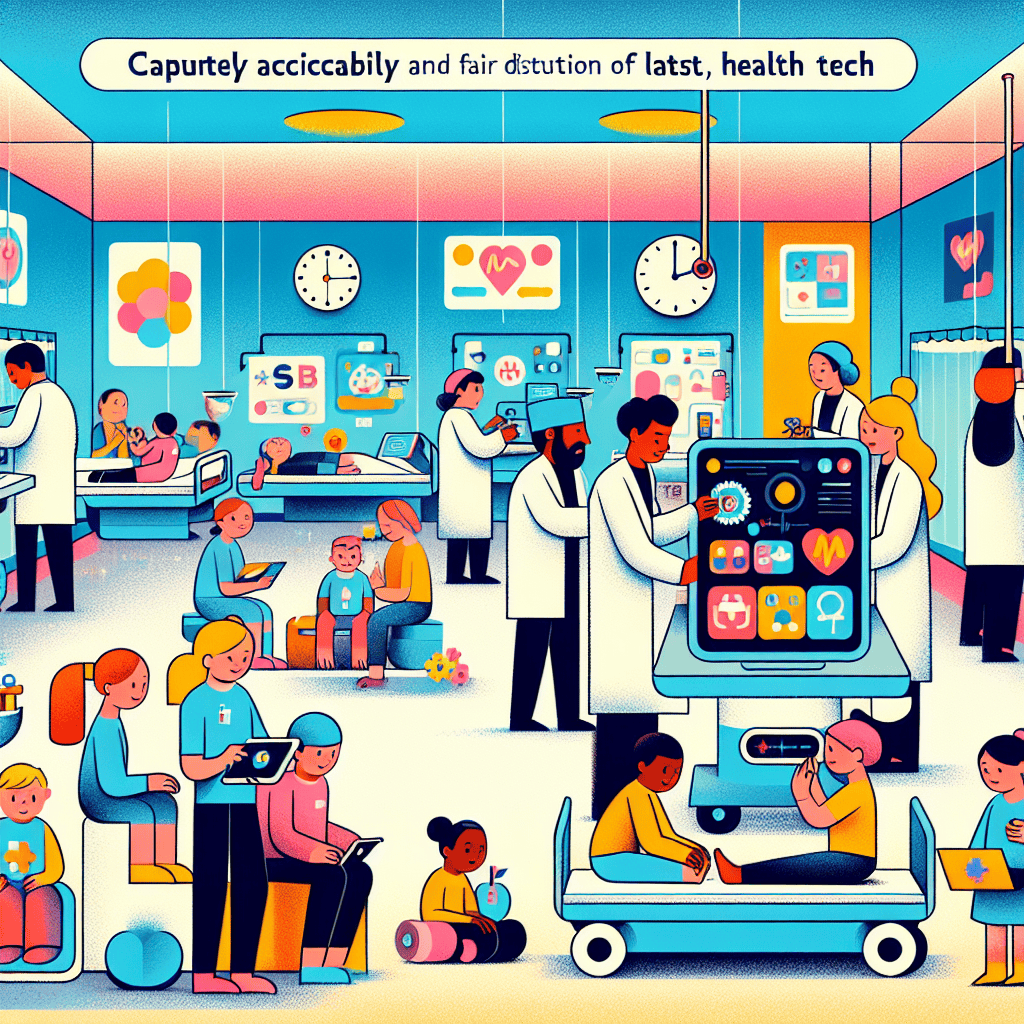Tackling Techquity at Children’s National Hospital

In the rapidly evolving landscape of healthcare, the integration of technology has become a pivotal factor in enhancing patient care and operational efficiency. However, the digital divide, often referred to as “techquity,” poses significant challenges, particularly in pediatric healthcare settings. Children’s National Hospital, a leading pediatric institution, has embarked on a mission to address techquity, ensuring equitable access to technology-driven healthcare solutions for all children. This article delves into the multifaceted approach taken by Children’s National Hospital to tackle techquity, exploring its strategies, challenges, and successes.
Understanding Techquity in Healthcare
Techquity, a portmanteau of “technology” and “equity,” refers to the equitable distribution and access to technological resources and innovations in healthcare. In pediatric settings, techquity is crucial as it directly impacts the quality of care and health outcomes for children from diverse backgrounds. The digital divide can exacerbate existing health disparities, making it imperative for institutions like Children’s National Hospital to address these inequities.
The Digital Divide in Pediatric Healthcare
The digital divide in healthcare is characterized by unequal access to digital tools and resources, which can hinder the delivery of quality care. In pediatric healthcare, this divide can manifest in several ways:
- Lack of access to telehealth services for families in rural or underserved areas.
- Limited availability of digital health records, affecting continuity of care.
- Inadequate digital literacy among patients and caregivers, leading to underutilization of available resources.
Children’s National Hospital recognizes these challenges and is committed to bridging the gap through targeted interventions and innovative solutions.
Impact of Techquity on Health Outcomes
Techquity plays a significant role in determining health outcomes, particularly for vulnerable populations. Studies have shown that children from low-income families or minority groups are more likely to experience barriers to accessing digital health services. This can lead to delayed diagnoses, suboptimal treatment plans, and poorer health outcomes.
By addressing techquity, Children’s National Hospital aims to improve health outcomes by ensuring that all children, regardless of their socio-economic status, have access to the same high-quality care and technological resources.
Case Study: Telehealth Implementation
One of the key initiatives undertaken by Children’s National Hospital to tackle techquity is the implementation of telehealth services. During the COVID-19 pandemic, telehealth emerged as a vital tool for maintaining continuity of care while minimizing the risk of virus transmission. However, the hospital recognized that not all families had the necessary technology or internet access to benefit from these services.
To address this, Children’s National Hospital launched a program to provide families with the necessary equipment and internet access. The program also included training sessions to improve digital literacy among caregivers, ensuring they could effectively use telehealth platforms.
The success of this initiative is evident in the increased utilization of telehealth services among previously underserved populations, leading to more timely interventions and improved health outcomes.
Strategies for Promoting Techquity
Children’s National Hospital employs a multi-pronged approach to promote techquity, focusing on several key strategies:
- Partnerships with technology companies to provide affordable devices and internet access to families in need.
- Development of user-friendly digital platforms that cater to diverse linguistic and cultural needs.
- Community outreach programs to raise awareness about available digital health resources.
- Training programs for healthcare providers to enhance their digital competencies and improve patient engagement.
These strategies are designed to create a more inclusive healthcare environment where technology serves as a bridge rather than a barrier.
Challenges in Achieving Techquity
Despite the progress made, achieving techquity is not without its challenges. Children’s National Hospital faces several obstacles in its quest to ensure equitable access to technology-driven healthcare:
- Funding constraints that limit the scope of techquity initiatives.
- Resistance to change among some healthcare providers and patients.
- Rapid technological advancements that require continuous adaptation and investment.
Addressing these challenges requires a concerted effort from all stakeholders, including healthcare providers, policymakers, and the community at large.
Innovative Solutions for Bridging the Techquity Gap
Children’s National Hospital is at the forefront of developing innovative solutions to bridge the techquity gap. By leveraging cutting-edge technology and fostering collaborations, the hospital is making significant strides in ensuring equitable access to healthcare for all children.
Leveraging Artificial Intelligence and Machine Learning
Artificial intelligence (AI) and machine learning (ML) are transforming healthcare by enabling more accurate diagnoses and personalized treatment plans. Children’s National Hospital is harnessing the power of AI and ML to enhance patient care and reduce disparities.
For instance, the hospital has implemented AI-driven diagnostic tools that can analyze medical images with high precision, reducing the likelihood of misdiagnosis. These tools are particularly beneficial for underserved populations who may not have access to specialized medical expertise.
Moreover, AI and ML are being used to develop predictive models that identify at-risk patients, allowing for early interventions and improved health outcomes. By integrating these technologies into its operations, Children’s National Hospital is setting a benchmark for techquity in pediatric healthcare.
Mobile Health Applications
Mobile health applications are another innovative solution being utilized by Children’s National Hospital to promote techquity. These applications provide patients and caregivers with easy access to health information, appointment scheduling, and medication reminders.
The hospital has developed a suite of mobile applications tailored to the needs of its diverse patient population. These applications are available in multiple languages and are designed to be user-friendly, ensuring that even those with limited digital literacy can benefit from them.
By empowering patients and caregivers with the tools they need to manage their health, Children’s National Hospital is fostering a more equitable healthcare environment.
Virtual Reality in Pediatric Care
Virtual reality (VR) is emerging as a powerful tool in pediatric care, offering immersive experiences that can alleviate anxiety and improve patient engagement. Children’s National Hospital is pioneering the use of VR in various aspects of patient care, from pre-surgical preparation to pain management.
For example, VR simulations are being used to familiarize children with medical procedures, reducing their fear and anxiety. Additionally, VR-based pain management techniques are providing an alternative to traditional pain relief methods, particularly for children with chronic conditions.
By integrating VR into its care protocols, Children’s National Hospital is enhancing the patient experience and promoting techquity by making advanced technologies accessible to all children.
Collaborations with Technology Companies
Collaborations with technology companies are a cornerstone of Children’s National Hospital’s strategy to tackle techquity. By partnering with industry leaders, the hospital is able to access cutting-edge technologies and resources that would otherwise be out of reach.
These collaborations have resulted in the development of innovative solutions such as telehealth platforms, AI-driven diagnostic tools, and mobile health applications. Moreover, technology companies often provide financial support and expertise, enabling the hospital to expand its techquity initiatives.
Through these partnerships, Children’s National Hospital is able to leverage the strengths of both the healthcare and technology sectors, creating a more equitable healthcare system for all children.
Community Engagement and Education
Community engagement and education are critical components of Children’s National Hospital’s approach to techquity. By involving the community in its initiatives, the hospital is able to better understand the needs and challenges faced by its diverse patient population.
The hospital conducts regular outreach programs to educate families about available digital health resources and how to access them. These programs also provide training sessions to improve digital literacy among patients and caregivers.
By fostering a sense of community and empowerment, Children’s National Hospital is creating a more inclusive healthcare environment where technology serves as a tool for positive change.
Measuring the Impact of Techquity Initiatives
To ensure the success of its techquity initiatives, Children’s National Hospital employs a robust framework for measuring their impact. By tracking key metrics and outcomes, the hospital is able to assess the effectiveness of its strategies and make data-driven decisions for continuous improvement.
Key Performance Indicators
Children’s National Hospital has identified several key performance indicators (KPIs) to measure the impact of its techquity initiatives. These KPIs include:
- Utilization rates of telehealth services among underserved populations.
- Patient satisfaction scores related to digital health services.
- Reduction in health disparities among different demographic groups.
- Improvement in health outcomes for at-risk patients.
By regularly monitoring these KPIs, the hospital is able to identify areas for improvement and make informed decisions to enhance its techquity efforts.
Case Study: Improved Health Outcomes
A recent case study conducted by Children’s National Hospital highlights the positive impact of its techquity initiatives on health outcomes. The study focused on a cohort of children with chronic conditions who were provided with access to telehealth services and mobile health applications.
The results showed a significant improvement in health outcomes, with patients experiencing fewer hospitalizations and emergency room visits. Additionally, caregivers reported higher levels of satisfaction with the care provided, citing the convenience and accessibility of digital health services as key factors.
This case study underscores the importance of techquity in improving health outcomes and demonstrates the effectiveness of Children’s National Hospital’s initiatives.
Feedback from Patients and Caregivers
Feedback from patients and caregivers is an invaluable source of information for Children’s National Hospital in assessing the impact of its techquity initiatives. The hospital regularly conducts surveys and focus groups to gather insights from its diverse patient population.
This feedback is used to identify areas for improvement and to tailor digital health services to better meet the needs of patients and caregivers. By actively involving the community in its initiatives, Children’s National Hospital is able to create a more patient-centered healthcare environment.
Continuous Improvement and Adaptation
Children’s National Hospital is committed to continuous improvement and adaptation in its quest to tackle techquity. The hospital regularly reviews its strategies and initiatives to ensure they remain relevant and effective in the face of evolving challenges and technological advancements.
This commitment to continuous improvement is reflected in the hospital’s willingness to embrace new technologies and approaches, as well as its dedication to fostering a culture of innovation and collaboration.
Challenges in Measuring Impact
While measuring the impact of techquity initiatives is essential, it is not without its challenges. Children’s National Hospital faces several obstacles in this regard, including:
- Data collection and analysis limitations, particularly in underserved populations.
- Difficulty in isolating the impact of specific initiatives from other factors influencing health outcomes.
- Ensuring the accuracy and reliability of self-reported data from patients and caregivers.
Despite these challenges, Children’s National Hospital remains committed to measuring the impact of its techquity initiatives and using this information to drive continuous improvement.
The Role of Policy and Advocacy in Promoting Techquity
Policy and advocacy play a crucial role in promoting techquity and ensuring equitable access to technology-driven healthcare solutions. Children’s National Hospital is actively involved in advocating for policies that support techquity and address the digital divide in healthcare.
Advocating for Equitable Access to Technology
Children’s National Hospital is a vocal advocate for equitable access to technology in healthcare. The hospital works closely with policymakers and stakeholders to promote policies that address the digital divide and ensure that all children have access to the same high-quality care.
These advocacy efforts include lobbying for increased funding for digital health initiatives, supporting legislation that promotes broadband access in underserved areas, and advocating for policies that address social determinants of health.
By championing these causes, Children’s National Hospital is helping to create a more equitable healthcare system for all children.
Collaborating with Government Agencies
Collaboration with government agencies is a key component of Children’s National Hospital’s advocacy efforts. The hospital works closely with agencies such as the Department of Health and Human Services (HHS) and the Federal Communications Commission (FCC) to promote policies that support techquity.
These collaborations have resulted in several successful initiatives, including programs to expand broadband access in rural areas and funding for telehealth services in underserved communities.
By working with government agencies, Children’s National Hospital is able to leverage their resources and expertise to promote techquity on a larger scale.
Engaging with Community Organizations
Community organizations play a vital role in promoting techquity and addressing the digital divide. Children’s National Hospital actively engages with these organizations to raise awareness about the importance of techquity and to advocate for policies that support equitable access to technology.
These partnerships have resulted in several successful initiatives, including community outreach programs to improve digital literacy and advocacy campaigns to promote broadband access in underserved areas.
By working with community organizations, Children’s National Hospital is able to amplify its advocacy efforts and create a more inclusive healthcare environment.
Challenges in Policy and Advocacy
While policy and advocacy are essential for promoting techquity, they are not without their challenges. Children’s National Hospital faces several obstacles in this regard, including:
- Political and bureaucratic barriers that can slow down the implementation of policies.
- Limited resources and funding for advocacy efforts.
- Resistance from stakeholders who may not prioritize techquity.
Despite these challenges, Children’s National Hospital remains committed to advocating for policies that promote techquity and address the digital divide in healthcare.
The Future of Techquity Advocacy
The future of techquity advocacy is promising, with increasing recognition of the importance of equitable access to technology in healthcare. Children’s National Hospital is at the forefront of this movement, leading the charge for policies that support techquity and address the digital divide.
As technology continues to evolve, the hospital will continue to advocate for policies that ensure all children have access to the same high-quality care and technological resources. By championing these causes, Children’s National Hospital is helping to create a more equitable healthcare system for all children.
Conclusion: A Vision for the Future
Children’s National Hospital’s commitment to tackling techquity is a testament to its dedication to providing equitable healthcare for all children. Through innovative solutions, strategic partnerships, and robust advocacy efforts, the hospital is making significant strides in addressing the digital divide and ensuring that all children have access to the same high-quality care.
The success of Children’s National Hospital’s techquity initiatives serves as a model for other healthcare institutions seeking to promote equity in the digital age. By prioritizing techquity, the hospital is not only improving health outcomes for its patients but also setting a benchmark for the future of pediatric healthcare.
As technology continues to evolve, Children’s National Hospital will remain at the forefront of efforts to promote techquity and create a more inclusive healthcare environment. By championing these causes, the hospital is helping to create a brighter future for all children, where technology serves as a tool for positive change rather than a barrier to care.





